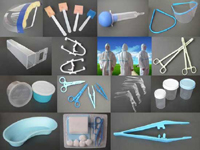|
Over the past three decades, the medical devices
market has undergone a number of changes in the types
of devices produced, substrates selected, and
sterilization procedures employed. In the early 1970s,
manufacturers were using materials like glass, rubber,
and metal to assemble syringes, surgical instruments,
and other devices. Products made from such materials
were typically machined, moulded, or assembled with
fasteners.
With the advances in technology, the need
for engineering plastics became indispensable for use
in intricate, high performance device designs. Around
the same time, a pronounced shift to single-use
devices forced design engineers to evaluate such
polymers as acrylic, polycarbonate, PVC and others.
In the initial stages progression was slow. Whereas
in 1950, the total volume of plastics produced and
used worldwide amounted to just 1.5 million tonnes,
the global figure for synthetic materials has soared
to today’s 280 million tonnes. About one fifth
is accounted for by Europe, the second largest
plastics producer in the world behind China.
Plastics - A Material of Choice for Medical
Innovations
Plastics stand for superior design flexibility
compared to other materials. Their properties can be
tailored to meet a wide spectrum of physical,
mechanical, chemical as well as biocompatibility
requirements. Many applications are using plastics to
replace either metal or glass to reduce costs,
leverage design flexibility, and still maintain the
performance. Polymer additives and fillers can be used
to render plastics flexible or rigid, insulating or
conductive, chemically resistant and sterilization
resistant.
|
Advances in high performance polymers and the
associated merits of plastics over other materials
have expanded the opportunities of plastics in the
medical industry, not only in devices but also in
packaging. Price pressures in the healthcare industry
are also driving the development of high-quality, low
cost alternative polymers.
Novel creations in polymer chemistry, e.g. improved
silicone elastomers, thermoplastics with antimicrobial
finishes, and the opportunities offered by
nanotechnology are expanding the variety of
applications, and more. They also help to enhance the
properties of products, such as Processibility or
resistance to fungal and bacterial attack.

Plastics remain at the
forefront of medical innovations. We rely on plastics
in every aspect of our lives. The plastics used in
healthcare and medicine support us from birth through
maturity and eventual old age. Many medical devices
incorporate polymers, either as key components or as
coatings to improve the biocompatibility of other
materials. Ultimately, plastics remain the forefront
of medical innovations. The dynamic and relentless
pace of Medical Device Industry development has been
matched by the development of specialist plastics.
Emerging Trends In
Medical Plastics |
Polymer
materials are very diverse and can be adapted for the
intended use i.e. Infusion tube, suitable for light
sensitive drugs, polymers which are degraded within
the body (bone screws), polymers which releases drugs,
etc. The inertness of polymers makes them more
suitable for critical applications like implants and
pharmaceutical packaging. The mega trend behind the
increasing use of polymers is the use of disposables,
which gives a better protection against cross
contamination and saves money for the sterilisation
and validation of these processes.
Medical
plastic compounds are used in a wide variety of
segments within the market, such as devices, equipment
housings and tray and fabrics. A substantial amount of
Polymeric Materials are used in Medical Device
Industry which is globally estimated to grow at
approx. 5 – 10 % on average. It is therefore estimated
that Plastics Materials / Compounds used in Devices
will also grow within this range.
While
the need for Innovation resulting from Regulatory,
Market and Cost Pressures demand that Medical Device
Manufacturers need developments in the Medical
Polymers.
There
is a trend towards devices with unique attributes from
materials of composition. Combination products, with
drugs blended into polymers, for local drug delivery
or controlled release is one of the most exciting
trends.
Another
area involves nano-reinforcements used to enhance the
physical properties of plastics at the molecular
level. This is important for vascular catheters that
are getting smaller with thinner walls, but must be
stiff enough to be pushed through vascular pathways.
Standard fiber reinforcements are simply too large to
be used in these extremely thin walls. |
